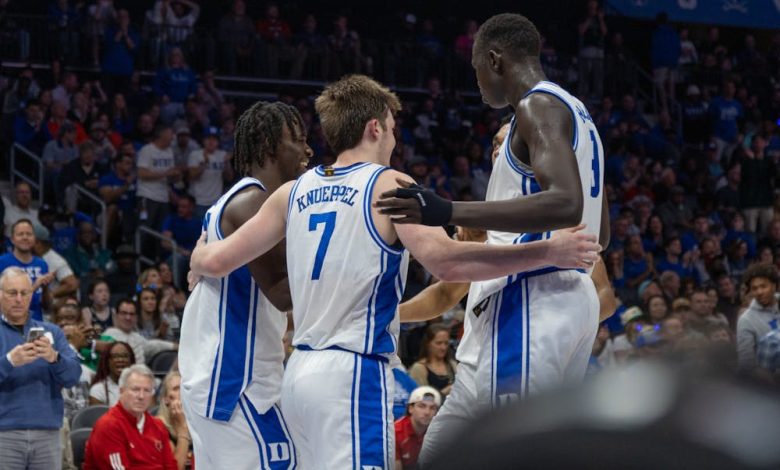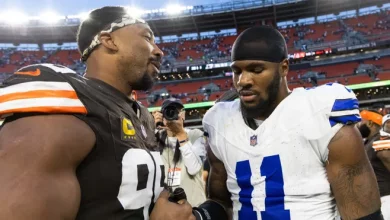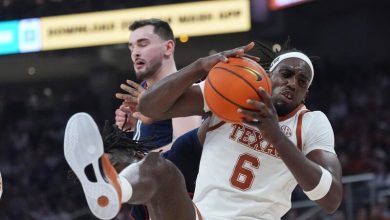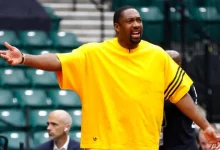How do past Blue Devil championship teams compare to the Duke men’s basketball team in 2025?

The Duke Blue Devils are a staple in college basketball history, boasting five NCAA championships (1991, 1992, 2001, 2010, and 2015). Under the leadership of legendary head coach Mike Krzyzewski, Duke developed a culture of excellence that attracted top-tier talent and consistently produced championship-caliber teams. As we look ahead to the 2025 NCAA Tournament, the question arises: How does the Duke men’s basketball team compare to past Blue Devil championship teams? What are the similarities and differences in terms of talent, leadership, team dynamics, and overall potential for success?
While the 2025 Blue Devils are still in the midst of their season, comparisons with Duke’s championship-winning teams offer valuable insight into the team’s potential. With a roster featuring elite talents such as Cooper Flagg, Tyrese Proctor, and Kon Knueppel, along with the leadership of head coach Jon Scheyer—who took over for Krzyzewski after his retirement—there are some compelling reasons to believe that the 2025 team could make a deep run in March Madness and even contend for a national championship. But how do they stack up against past Duke teams that have etched their names in the history books?
In this article, we’ll explore the key factors that contribute to championship success—team chemistry, leadership, star power, coaching, and depth—and compare these aspects between Duke’s championship teams of the past and the 2025 squad.
The 1991 and 1992 Championships: The Rise of the Blue Devils
The 1991 and 1992 Duke teams are often regarded as two of the greatest in college basketball history. These back-to-back championships, led by Coach K, marked the beginning of Duke’s era of dominance. The 1991 team, featuring stars such as Christian Laettner, Bobby Hurley, and Grant Hill, set the standard for excellence that Duke would uphold for decades. The following year, the 1992 team, which included Laettner, Hurley, Hill, and newcomer Thomas Hill, is often remembered for its remarkable depth and ability to execute in clutch moments.
Leadership and Star Power
One of the defining features of these teams was their star power, especially in the form of Christian Laettner, who was one of the most dominant college players of his era. Laettner’s presence on the floor, coupled with Bobby Hurley’s leadership as the floor general, made these teams nearly unstoppable. Their ability to dominate on both ends of the floor, with Laettner as the primary scorer and Hurley orchestrating the offense, set the tone for the entire program.
Team Chemistry
The 1991 and 1992 Blue Devils were defined by their incredible team chemistry. This was a tightly-knit group that trusted each other implicitly on both offense and defense. Coach K instilled a system that emphasized defense, rebounding, and unselfish play. The result was a team that played with an intensity and precision rarely seen in college basketball.
Comparing to the 2025 Blue Devils
Fast forward to 2025, and the Blue Devils feature a team filled with high-profile recruits, including Cooper Flagg, who is one of the most highly anticipated players in recent years. Like Laettner, Flagg brings a versatile skill set, contributing on both ends of the floor. While he may not yet have the same level of dominance as Laettner, Flagg has the potential to carry a team in the way Laettner did in 1991 and 1992.
Tyrese Proctor, like Hurley before him, serves as the floor general and playmaker for the team. Proctor’s ability to facilitate the offense and control the tempo will be key for the Blue Devils’ success, especially in high-pressure tournament games. Much like Hurley, Proctor’s leadership will be integral in the 2025 team’s tournament run.
However, one area where the 2025 Blue Devils may differ from the 1991 and 1992 teams is in the style of play. The game has evolved over the past few decades, and Duke’s offense is more perimeter-oriented, with an emphasis on spacing and three-point shooting. While the 1991 and 1992 teams relied heavily on post play and mid-range shooting, the 2025 team’s ability to space the floor and shoot from beyond the arc could give them a distinct advantage in a modern tournament setting.
The 2001 Championship: A Balanced, Deep Team
The 2001 Duke team, led by stars like Jason Williams, Shane Battier, and Carlos Boozer, is often considered one of the most well-rounded teams in college basketball history. While the 1991 and 1992 squads were marked by their star power, the 2001 team stood out for its balance and depth. Williams was the flashy point guard who could score and facilitate, while Battier provided elite defense and leadership. Boozer and Mike Dunleavy were versatile forwards who could score inside and outside.
Depth and Versatility
What set the 2001 team apart was its depth. The Blue Devils were loaded with talent at every position, from Williams running the offense to Battier’s defensive prowess and Dunleavy’s scoring. The team’s versatility made them difficult to defend, as they could attack in multiple ways. Additionally, Coach K’s defensive schemes were as effective as ever, with Battier serving as the team’s anchor on that end of the floor.
Comparing to the 2025 Blue Devils
In terms of depth, the 2025 Blue Devils are similar to the 2001 team. While Cooper Flagg may be the standout star, Duke also has a strong supporting cast, including Tyrese Proctor, Kon Knueppel, and Mark Mitchell. Like the 2001 team, Duke in 2025 has multiple players capable of stepping up in big moments. The versatility of players like Flagg and Mitchell, who can play both inside and on the perimeter, mirrors the multifaceted game of the 2001 squad.
Moreover, Coach Jon Scheyer, while still in his early years as head coach, has emphasized defense and team-oriented play. Much like Coach K’s approach with the 2001 team, Scheyer understands that a balanced, deep roster is critical to success in March Madness.
The 2010 Championship: A Defensive Juggernaut
The 2010 Duke team, led by Kyle Singler, Jon Scheyer, Nolan Smith, and a young Mason Plumlee, was built on defense and unselfish offense. Unlike the more offensively explosive teams of the past, this group’s calling card was its defense, with a focus on limiting opponents’ scoring opportunities and wearing them down over 40 minutes. The offense, while efficient, relied on the ability of players like Scheyer and Singler to create scoring opportunities in a team-oriented system.
Defense and Leadership
The 2010 team was led by veterans who had been through the rigors of multiple seasons and were battle-tested. Scheyer, Singler, and Smith formed a leadership core that was both talented and experienced. Their ability to maintain composure in tight games was one of the keys to their championship run.
Comparing to the 2025 Blue Devils
The 2025 Blue Devils, while still finding their rhythm as a cohesive unit, have the potential to build a defensive identity similar to the 2010 team. With players like Flagg and Mitchell capable of guarding multiple positions and affecting the game on the defensive end, the 2025 team could develop a defensive mentality that allows them to thrive in the tournament’s high-pressure environment. In particular, Flagg’s shot-blocking and ability to disrupt opponents’ offenses mirrors some of the defensive contributions made by Singler and Plumlee in 2010.
However, where the 2025 team may differ is in its offensive explosiveness. With players like Flagg and Proctor capable of scoring in multiple ways, the 2025 squad may be more versatile offensively than the 2010 team. The ability to score both inside and from beyond the arc could be a major advantage in the modern NCAA Tournament.
The 2015 Championship: A Mix of Youth and Experience
The 2015 Duke team, which secured its fifth NCAA title, was an interesting mix of youthful energy and veteran leadership. The team featured the likes of Jahlil Okafor, Justise Winslow, Tyus Jones, and Quinn Cook. Okafor was a dominant presence in the paint, while Winslow brought athleticism and versatility. Tyus Jones, the MVP of the Final Four, provided clutch playmaking in key moments. This team’s success was built on its ability to blend star power with complementary role players who executed the game plan to perfection.
Leadership and Clutch Performances
One of the most significant factors in the 2015 championship run was the leadership of Tyus Jones. His calm demeanor and clutch playmaking in critical moments helped guide Duke through the tournament’s most challenging games. His performance in the Final Four and championship game remains one of the most memorable in recent Duke history.
Comparing to the 2025 Blue Devils
The 2025 Blue Devils are still developing their leadership dynamic, but Tyrese Proctor has the potential to take on the same type of leadership role that Jones did in 2015. Proctor’s ability to facilitate the offense and create opportunities for his teammates could be pivotal in the tournament’s later rounds. If Proctor can step into a similar leadership role and make clutch plays when needed, the 2025 team could follow a similar path to success as the 2015 squad.









